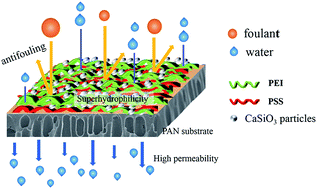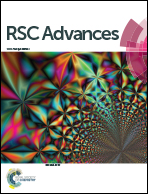Self-cleaning and antifouling nanofiltration membranes—superhydrophilic multilayered polyelectrolyte/CSH composite films towards rejection of dyes
Abstract
Superhydrophilic poly(ethyleneimine)/poly(sodium-4-styrenesulfonate) (PEI/PSS)–calcium silicate hydrate (CSH) multilayered membranes (PEI/PSS)2.0(PEI/PSS–CSH)n on polyacrylonitrile (PAN) substrate were prepared via layer-by-layer (LbL) assembly with in situ precipitation of consecutive Ca2+-integrated multilayered polyelectrolytes and sodium silicate. The surface structure and properties of these multilayered membranes (PEI/PSS)2.0(PEI/PSS–CSH)n were characterized by zeta potential, infrared resonance spectra, water contact angles, scanning electron microscopy, and atomic force microscopy, and the separation performances were evaluated by rejection of dyes, such as xylenol orange (XO) and rhodamine B (RB). The long term performance, self-cleaning and antifouling behaviors were investigated by retention of aqueous solutions of both dyes and bovine serum albumin (BSA) aqueous solution. The results indicated that the in situ incorporation of controlled CSH contents into PEI/PSS multilayers greatly improved the hydrophilicity of the multilayered membranes, resulting in the formation of a superhydrophilic (PEI/PSS–CSH)2.0 membrane with a water contact angle of 2.1° and the highest permeate fluxes of 191.5 and 183.5 L m−2 h−1 MPa−1 accompanied by the rejection of 94.0% and 91.2% for XO and RB aqueous solutions, respectively. When the number of assembled (PEI/PSS–CSH)n multilayers was higher than 2.0 bilayers, the rejection increased but the flux markedly decreased to XO and RB dyes, showing a characteristic trade-off phenomenon. Moreover, the superhydrophilic (PEI/PSS–CSH)2.0 membrane possessed a higher antifouling and self-cleaning behavior than the hydrophilic polyelectrolytes (PEI/PSS)2.0.


 Please wait while we load your content...
Please wait while we load your content...